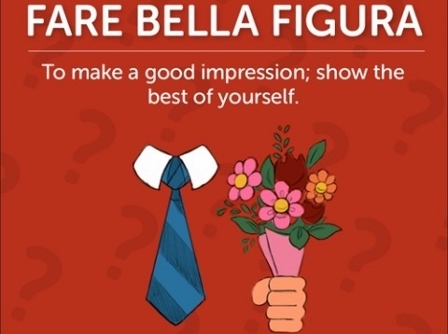
 Giosué Prezioso
Giosué Prezioso
Italian language: The origin of the expression “BELLA FIGURA”
- WTI Magazine #76 Feb 14, 2016
-

 Giosué Prezioso
Giosué Prezioso
WTI Magazine #76 2016 February 15
Author : Giosuè Prezioso Translation by:
Stereotypically, Italy is the country of the good food, fashion, art, music and, more generally, of culture. Dante Alighieri, the Poet par excellence, defined it the "Bel Paese", meaning the "Beautiful Country", as in fact did Kahlil Gibran - stating that "The art of the Italians is in beauty" - and then J. W. Goethe, S. Johnson, H. Sienkiewicz and many others. Italy and beauty have become, basically, synonyms.
Ca va sans dire, in a country where beauty is the liaison linking food with architecture, fashion with art, and so on, literature and daily language cannot differ. There is, in fact, a colloquial expression that links beauty with manners, but also with politeness, language, gesture, and appropriateness, this is the concept behind "Fare Bella Figura".
Literally, it means "to make a good figure", translatable as "to give a good impression", "be/make something appropriate", but also to buy/to dress/to cook and do any action "in order to be appreciable".
The origin of the expression is quite ambiguous. According to the "Dizionario dei Modi di Dire" (Hoepli Editore), it may come from a comment made by the King Carlo Felice di Savoia. In Turin, where he lived, there was a very wealthy exuberant entrepreneur who ran a chocolate-firm. In order to show off his power, the rich man bought a luxurious enviable coach, which the King saw and heard of. Furious, the monarch commented: "When I go out with my coach, I do not want [give the impression] I look like [a/the] chocolate-maker!" (Quando esco in carrozza non voglio fare la figura di un cioccolataio!). "Fare la figura di un cioccolataio" (literally: "to make the figure of a chocolate-maker") meant "to resemble a/the chocolate-maker". This comment implies that, the King, did not mean to resemble the "figure" of the entrepreneur, referring, then, to the way he looked like. Therefore, "Fare Bella Figura" is strictly linked to visualizing, seeing, and appearing.
It seems that, in order to "Fare Bella Figura", you need to see yourself from the outside, as an alter ego. Then, take this being and do your best in order to make him/her look, be and act in an admirable way, as a "beautiful figure", "una bella figura". "With these shoes, I can make a 'Bella Figura!"; "I like this glasses, I can make a 'Bella Figura!". By making of yourself what you believe is appropriate, you can be a "Bella Figura", and, as a result, you can make a "Bella Figura".
However, "Figura" is present also in English. The verb "to figure out", used to visualize the way of solving a situation is, in fact, extremely figurative: "I need to figure out what's wrong this car!". By saying "figuring out", we mean to extrapolate an image of what is going on, making visual and rather representative something we imagine. "Fare Bella Figura" comes from the same visualization. In order to "give a good impression" or "to make something appropriate", we need to visualize ourselves, literally to figure us out.
This slightly recalls the myth of Pygmalion, the Cyprian sculptor who, after figuring out how his sculpture had to look like, ended up falling in love with it (such a "Brutta Figura", a bad figure, he made!).
Besides "Bella Figura", there are other versions, such as "Fare Brutta Figura" (to give a bad impression), "Fare una Figuraccia" (to give a very bad impression), or "Fare un Figurone!" (to give a great impression!), which can be applied in any circumstance, referring to things, people, or occasions.
As the country of "beauty" (in Gibrans' words), Italy makes of its language a code which observes forms, shapes, harmonies and tones, but, at first, it observes its figure as a king, like Carlo Felice di Savoia, who, because of his pride, coined an expression which is a story, a figurative story.